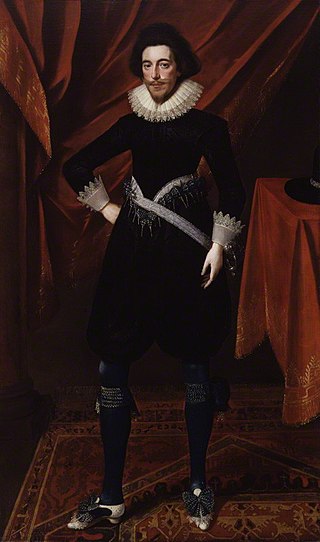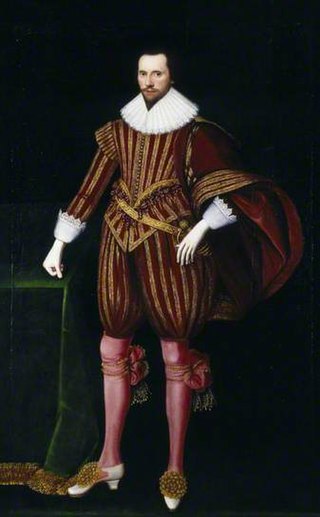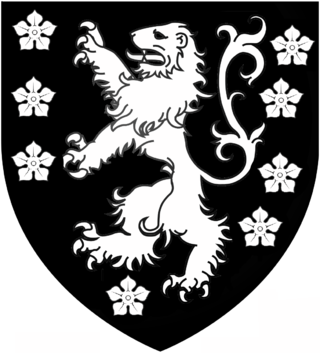Related Research Articles

Robert Devereux, 3rd Earl of Essex, KB, PC was an English Parliamentarian and soldier during the first half of the 17th century. With the start of the Civil War in 1642, he became the first Captain-General and Chief Commander of the Parliamentarian army, also known as the Roundheads. However, he was unable and unwilling to score a decisive blow against the Royalist army of King Charles I. He was eventually overshadowed by the ascendancy of Oliver Cromwell and Thomas Fairfax, and resigned his commission in 1646.

Sir John Gell, 1st Baronet was an English landowner from Derbyshire, who acted as local Parliamentarian commander for most of the First English Civil War before resigning in May 1646. He was notorious for parading the body of his Royalist opponent through Derby after the Battle of Hopton Heath in March 1643.

The First English Civil War took place in England and Wales from 1642 to 1646. It is part of the 1639 to 1653 Wars of the Three Kingdoms, which also include the Bishops' Wars, the Irish Confederate Wars, the Second English Civil War, the Anglo-Scottish war (1650–1652) and the Cromwellian conquest of Ireland. Historians calculate some 15% to 20% of all adult males in England and Wales served in the military between 1639 and 1653, while around 4% of the total population died from war-related cause, versus 2.23% in World War I. These figures illustrate the impact of the conflict on society in general, and the bitterness it engendered.

Sir Edward Rossiter was an English landowner, soldier and politician from Lincolnshire. He fought with the Parliamentarian army in the Wars of the Three Kingdoms and sat as an MP at various times between 1646 and 1660.

Sir Michael Livesey, 1st Baronet, also spelt Livesay, was a Puritan activist and Member of Parliament who served in the Parliamentarian army during the Wars of the Three Kingdoms. He was one of the regicides who approved the Execution of Charles I in January 1649.

Robert Greville, 2nd Baron Brooke was a radical Puritan activist and leading member of the opposition to Charles I of England prior to the outbreak of the First English Civil War in August 1642. Appointed Parliamentarian commander in Staffordshire and Warwickshire, he was killed by a Royalist sniper at Lichfield on 2 March 1643.
The Eastern Association of counties was an administrative organisation set up by Parliament in the early years of the First English Civil War. Its main function was to finance and support an army which became a mainstay of the Parliamentarian military effort until early 1645, when many of its units were incorporated into the New Model Army.
During the first English Civil War, the Parliamentarians used their control of the legislature to enforce a number of laws to support their military campaign, including the levying of funds. On 26 November 1642, the Committee for the Advance of Money for the Service of the Parliament was established.

Francis Seymour, 1st Baron Seymour of Trowbridge, of Marlborough Castle and Savernake Park in Wiltshire, was an English politician who sat in the House of Commons at various times between 1621 and 1641 when he was raised to the peerage as Baron Seymour of Trowbridge. He supported the Royalist cause during the English Civil War.

Sir Gervase Clifton, 1st Baronet, K.B. was an English politician who sat in the House of Commons at various times between 1614 and 1666. He supported the Royalist cause in the English Civil War. He was educated at St John's College, Cambridge.

Sir William Morley, JP was an English politician who sat in the House of Commons at various times between 1626 and 1642. He supported the Royalist cause in the English Civil War.
Sir John Corbet, 1st Baronet of Stoke upon Tern was an English politician who represented Shropshire in the House of Commons of the long Parliament. As s moderate Puritan, he was noted before the English Civil War for his campaigns against extra-parliamentary taxation, and for waging a long running dispute over control of his parish church at Adderley which led to his imprisonment. He was a notable member of the Shropshire county committee, responsible for pursuing the war against the royalists. As a part of a Presbyterian middle group in Parliament, he was one of those secluded from parliament by Pride's Purge, and was stripped of his remaining public offices after the Restoration.

Robert Brewster (1599–1663) was an English landowner of Parliamentarian sympathies who sat in the House of Commons at various times between 1645 and 1659.
Lionel Gatford was a royalist Church of England clergyman.
Thomas Leedes was an English politician who sat in the House of Commons from 1640 to 1642. He supported the Royalist cause in the English Civil War and was killed in action fighting for the King.
Sir William Smyth, 1st Baronet was an English politician who sat in the House of Commons at various times between 1640 and 1679. He supported the Royalist cause in the English Civil War.
The Stour Valley riots, also called the Anti-Popery riots, were a series of anti-Roman Catholic riots and attacks which took place across southern East Anglia throughout 1642. The unrest was concentrated in the area surrounding the River Stour, Suffolk.
Between 1642 and 1651 the Channel Islands were involved in an eleven-year-long, wide-scale armed conflict known as the English Civil War, between the Parliamentarians and Royalists over, principally, the manner of England's government and the amount of power the monarch should be able to wield.
William Heywood or Haywood (1599/1600–1663) was a Church of England clergyman who supported the Royalist cause in the English Civil War. He later became domestic chaplain to Archbishop William Laud, chaplain in ordinary to King Charles I, prebendary at St Paul's Cathedral and Rector of St Giles in the Fields church in London.

The Church of St Clare, Bradfield is the Anglican parish church of Bradfield St Clare, in the district of West Suffolk, Suffolk. The original structure dates back to the 12th century, with modifications being made through the 13th, 14th and 15th centuries. The building was restored in 1874. It is a Grade II* listed building.
References
- Archives in London and the M25 area Senate House Library, University of London Accessed 1 April 2008.
- Foster, William Edward, (Annotator (c. 1891)) The Plundered Ministers of Lincolnshire; Being Extracts from the Minutes of the Committee of Plundered Ministers, Guildford : Printed by Billing and Sons. different text formats, The Internet Archive